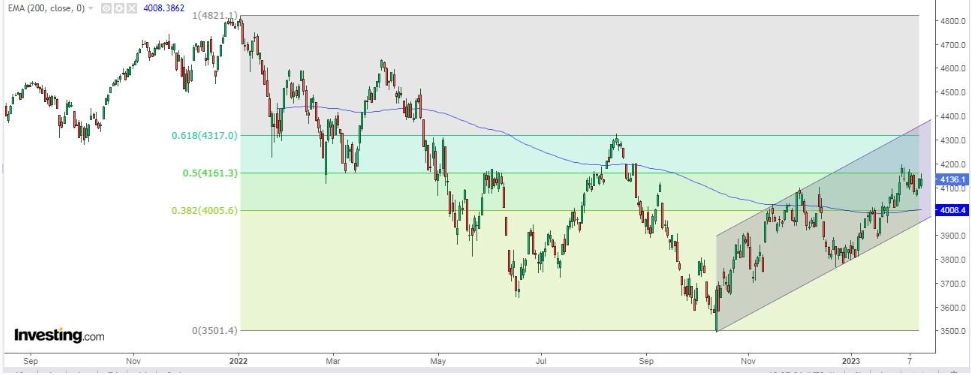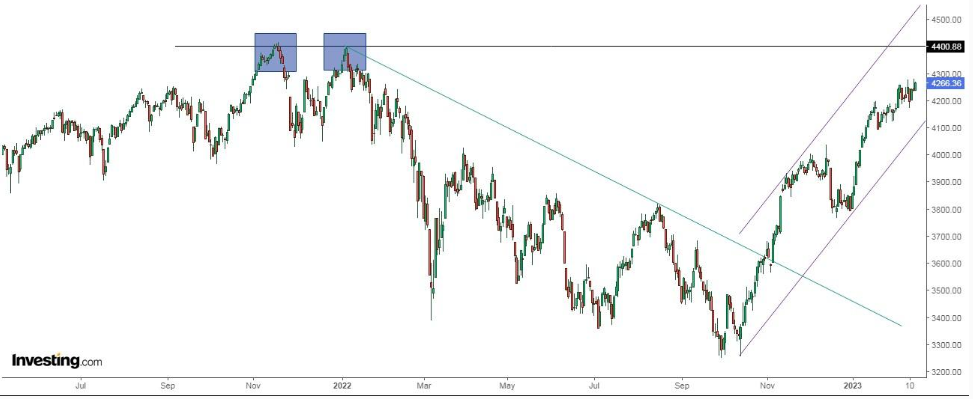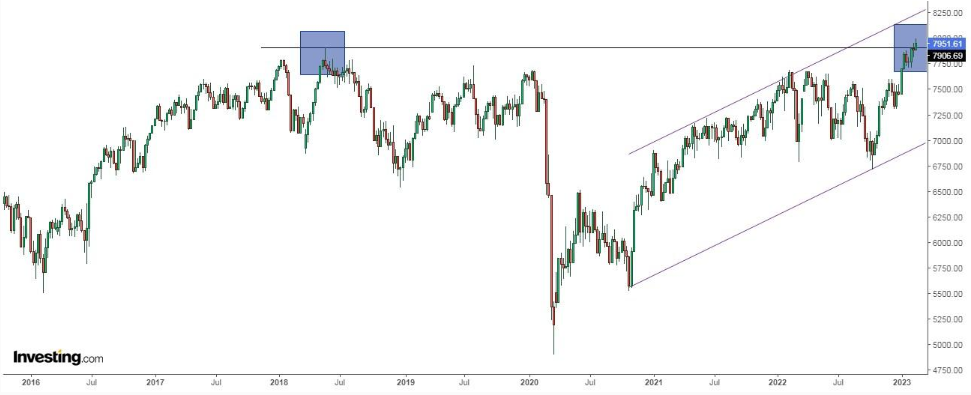- FTSE 100 has been least impacted by the war in Ukraine, while Germany's DAX has been hardest hit
- The S&P 500 experienced high volatility in 2023. However, technical indicators suggest that it remains within a bullish channel
- The Euro Stoxx 50, however, is outperforming the S&P 500 so far for 2023 due to its lower exposure to the technology sector
Two days after Russia invaded Ukraine last year, I outlined which markets I thought would prove more resilient in the face of the largest war on European soil since World War II.
My view was that, among European markets, the UK FTSE 100 would be the most resilient, while the German DAX would be one of the most affected — which ended up proving to be the case for 2022.
There is no merit in predicting that, as it was only logical; the FTSE because of its higher exposure to commodities and the DAX due to its reliance on Russia's and Ukraine's exports.
Now, as we approach the 1-year anniversary of the invasion, let's look at the S&P 500, the Euro Stoxx 50, the FTSE 100, and the 60/40 portfolio to consider what are the best investment alternatives going forward.
S&P 500

Here are some facts you may not know:
- Many investors probably think that it is not very common for the S&P 500 to move 10% up or down. In fact, it is quite the opposite: since 1950, we have seen it in 51 years, 39 of which have been up and 12 of which have been down, i.e. almost 70% of the time.
- When the S&P 500 rose by +5% or more on the 25th day of a new year (as will be the case in 2023), the average return for the rest of the year was +17.6%, and the year ended in the green 16 out of 17 times, with the sole exception of 1987.
- So far this year, there have been 15 days when the S&P 500 moved 1% or more either up or down (9 up, 6 down). In the last 50 years, this is the tenth year in which there have been 15 or more days with such a move. This is indicative of the prevailing volatility.
- Nearly 80 of the stocks in the S&P 500 have risen +50% or more from their 52-week lows.
Technically, the index has maintained its upward momentum since forming a bottom in mid-October and remains within its bullish channel.
The break above the 200-day moving average at the end of January confirmed its strength.
But why has it not continued to rise since the beginning of February? If you look at the chart, you can see that by plotting the Fibonacci, we get a series of levels that act as targets for the rise. The first target was reached in November, and the second in early February.
Fibonacci levels not only act as possible targets. They also tend to act as support or resistance. This happened when the first target was reached, which was difficult to break, and now the same is happening with the second target.
The third target is extremely interesting, not only because it is a Fibonacci level but also because it is a resistance. Hence, the day it reaches 4305, it will probably rest, oxygenate and bounce down.
Euro Stoxx 50

I predicted that European equities would outperform US equities by 2023 on Jan. 9. So far, the S&P 500 is up +8.02%. The Euro Stoxx 50 is up +13.54%.
It's true that banks are benefiting from rising rates, and both the Federal Reserve and the European Central Bank are set to continue doing so. However, this is a positive for European equities as the exposure to banks is higher in Europe, especially in indices such as the IBEX 35.
In addition, the technology sector is the one that suffers the most because of the interest rate hikes, and European equity markets have less exposure compared to Wall Street.
As if that were not enough, there are also European markets with greater exposure to commodities, such as the UK FTSE and the energy sector.
From a technical point of view, the Euro Stoxx 50 continues to rise from the October lows.
We must be careful because it is approaching strong resistance at 4400-4402, formed in November 2021 and unsuccessfully tried to break in January 2022.
Therefore, when it reaches this level, it is likely that it will break it in the first few attempts and will move lower.
FTSE 100

The UK's FTSE is not often discussed, or at least not as much as it should be.
The index was created in 1984. It is the UK's main index and comprises of 100 companies with the largest market capitalization.
The index is reviewed every three months, on the first Friday in March, June, September, and December.
A few days ago, it reached new record highs. Its composition makes it somewhat different from the others. Among the 100 companies that make up the index, there is always a high weighting of companies in the commodities sector.
This means that when commodities are in a bull market, the FTSE 100 tends to be the best-performing stock market in Europe.
It is precisely because of its higher weighting in commodity-related companies and lower exposure to the technology sector that the FTSE 100 has outperformed most of its peers in 2022.
It was up +0.91% compared with -8.78% for the Dow Jones Industrial Average, -33% for the Nasdaq 100, -5.56% for the IBEX 35, -11.74% for the Euro Stoxx, -12.35% for the DAX and -9.37% for the Nikkei 225.
60/40 Portfolio
Year after year, two types of portfolios attract the most interest from investors. One is the 25/25/25/25 portfolio, which consists of four assets, such as shares, bonds, commodities, and cash, all in equal parts.
However, the 60/40 portfolio is undoubtedly the most popular. This is a portfolio made up of 60% shares and 40% bonds. This is why it is also called a balanced portfolio.
It is based on investing 60% of the capital in shares, which have a higher risk potential and a higher return potential, and 40% in bonds.
Well, 2022 wiped it all out. On a total return basis, the S&P 500 was down 18.1%, the 10-year Treasury was down 17.8%, and the 60/40 portfolio was down 18%.
But despite this poor performance last year, the 60/40 portfolio has historically performed well. In fact, if we look at the last 95 years, we see that it had positive returns in 73 years and losses in only 22.
The worst years were:
- Year 1931: -27.3%.
- Year 1937: -20.7%.
- Year 2022: -18%.
- Year 1974: -14.7%.
- Year 2008: -13.9%.
The best years were:
- Year 1954: +32.9%.
- Year 1995: +31.7%.
- Year 1933: +30.7%.
- Year 1935: +29.8%.
- Year 1985: +29%.
Disclosure: The author does not own any of the securities mentioned.
